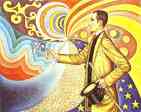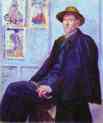Olga's Gallery
Dear Friends of Art,
During the past month we worked hard to prepare materials on some Pointillist
painters. We've succeeded in introducing the collections of Georges
Seurat, Paul Signac, Henri-Edmond
Cross, Maximilien Luce, Georges
Lemmen, Theo Van Rysselberghe,
Charles Angrand. The arrival
of this trend, called Neo-Impressionism, Pointillism or Divisionism, caused
a scandal equal to that caused by Impressionism in its time. The only art
critic, who admired and greeted the new art was Félix Fénéon
(1861-1944), an officer at the Ministry of Defense, intellectual, journalist
and ardent devotee of art. Today's story is about him.
Félix Fénéon and Pointillism
 Félix
Fénéon was born in Turin. In 1881 he took a post in
Paris at the Ministry of Defense. He was tall, with a thin angular face,
goat beard, piercing eyes of uncertain grayish-blue color with golden sparkles.
'Mysterious', 'enigmatic', 'Mephistopheles-like', 'demonic' - these were
epithets used with the name of this person.
Félix
Fénéon was born in Turin. In 1881 he took a post in
Paris at the Ministry of Defense. He was tall, with a thin angular face,
goat beard, piercing eyes of uncertain grayish-blue color with golden sparkles.
'Mysterious', 'enigmatic', 'Mephistopheles-like', 'demonic' - these were
epithets used with the name of this person.
'His sharp mind, bright and forecasting, troubled people. The self-insurance with which he related his ideas, shocking in their originality, exasperated his listeners and gave birth to vague, disturbing, anxious feeling of their own incompetence and inferiority,' wrote Henri Perruchot.
 As
soon as Félix Fénéon appeared at the eighth and final
Impressionist exhibition in 1886, at which Seurat's La
Grande Jatte was shown, he immediately estimated the historical
importance of the new art technique. The future generations will remember
1886, because the age of Manet and
Impressionism had come to its logical end and the age of Neo-Impressionism
began, stated Félix Fénéon. 'Neo-Impressionism' was
the term, introduced by him to denote the new movement, it showed on one
hand its connection with Impressionism, which experimented with light and
color, and on the other hand denoted the new style with its 'conscious
and scientific' approach towards the problems of color and light. The 'bull
confusion', so Fénéon called the reaction of the public to
the unusual technique of Seurat, Signac and other Pointillists.
As
soon as Félix Fénéon appeared at the eighth and final
Impressionist exhibition in 1886, at which Seurat's La
Grande Jatte was shown, he immediately estimated the historical
importance of the new art technique. The future generations will remember
1886, because the age of Manet and
Impressionism had come to its logical end and the age of Neo-Impressionism
began, stated Félix Fénéon. 'Neo-Impressionism' was
the term, introduced by him to denote the new movement, it showed on one
hand its connection with Impressionism, which experimented with light and
color, and on the other hand denoted the new style with its 'conscious
and scientific' approach towards the problems of color and light. The 'bull
confusion', so Fénéon called the reaction of the public to
the unusual technique of Seurat, Signac and other Pointillists.
Actually he was the only critic who "proved capable of articulating an appreciation of Seurat's picture, and the new method of painting it exemplified, in words notable for their objective tone." (Hajo Düchting. Seurat. The Master of Pointillism.) Félix Fénéon defined to the public the idea that stood behind the new techniques,
"If one looks at any uniformly shaded area in Seurat's Grande Jatte, one can find on every centimeter of it a swirling swarm of small dots which contains all the elements which comprise the color desired. Take that patch of lawn in the shade; most of the dots reflect the local colors of the grass, others, orange-colored and much scarcer, express the barely perceptible influence of the sun; occasional purple dots establish the complementary color of green; a cyanine blue, necessitated by an adjacent patch of lawn in full sunlight, becomes increasingly dense closer to the borderline, but beyond this line gradually loses in intensity… Juxtaposed on the canvas but yet distinct, the colors reunite on the retina: hence we have before us not a mixture of pigment colors but a mixture of variously colored rays of light."
Fénéon's love for art was absolute, and even formed his
political tastes. The failure by the "bourgeois" society to understand
the real artists, its admiration with commonplace hacks, 'sugary masters
of schools and academies', and its accusation of new and fresh trends -
all this was enough for Fénéon to justify the destruction
of that society. Fénéon approved of Anarchistic propaganda,
even its extreme forms, which called for action using bombs.
Some works by Impressionists hang on the walls of his study in the
Ministry of Defense. Later, when Anarchists' terrorist attacks shocked
France,
some explosives would be found in the same study.
Strange as it might seem to us now, many artists, including Paul Signac,
Camille and Lucien Pissarro, Maximilien Luce, Théo van Rysselberghe,
and others not only justified and glorified Anarchists, but supported them
financially.
Signac wrote that once Fénéon analyzed the logic of Anarchists'
attacks: the one at the stock exchange was against the bourgeoisie, others
were against the army, deputies, representatives of power, one more seemed
most strange and illogical, because it involved innocent civilians. Fénéon
denoted the last attack as an act against electors. He considered that
the terrorist act against electors was the most 'anarchistic' because electors
were more guilty than the elected, who only fulfill the electors' will.
In March of 1892 French police talked about Fénéon as
an'active Anarchist', they had him shadowed. In April his apartment and
office in the Military Ministry were searched. Police found some explosives
and Fénéon was arrested and imprisoned. Preliminary investigation
ended on June 8, and the case was handed down to the jury.
In summer of 1892 Fénéon together with other intellectuals,
publishers and journalists of the Anarchists' media, among others was Maximilien
Luce, appeared in court. The case was called the Trial of the Thirty. All
the arguments the police gave against the thirty did not meet jury's approval
and on August 12, Fénéon and the majority of the other defendants
were discharged.
 Despite
the discharge the police didn't believe in Fénéon's innocence.
Once the prefect told Mme Fénéon who came to complain that
the police continued shadowing her husband, "Madam, I'm sorry to say this,
but you've married a killer.'
Despite
the discharge the police didn't believe in Fénéon's innocence.
Once the prefect told Mme Fénéon who came to complain that
the police continued shadowing her husband, "Madam, I'm sorry to say this,
but you've married a killer.'
The Military Ministry fired M Fénéon, of course. His
lawyer T. Natanson, offered him a post as editorial secretary of his 'La
Revue Blanche". He worked for the magazine until 1903, and also organized
exhibitions. In 1906-1925 Fénéon was the Director of the
Bernheim-Jeune art gallery. His sharp remarks and snobbism towards 'bad
taste' might have repelled customers, but his unmistakable sense for real
art, his inability to cheat while selling items of art attracted them.
If he offered to buy an item of art, it meant that he admired it himself.
In 1925, when Fénéon was 63, he said to one of his friends,
'I am ready for idleness' and left the gallery. Publishers and art historians
attacked him with offers to write memoirs, Fénéon refused.
He refused to re-issue his only book 'Impressionism in 1886', refused to
issue a collection of his journalistic essays. He prepared a catalogue
of Seurat's works, but refused to put his name as the author.
'It's so silly to go on living, when you're 78 (or 79, or 80, or 81)'
he often said. During his last year he burnt all the documents and papers
he had in his possession and presented most of his collection to friends.
Félix Fénéon died on February 29, 1944.